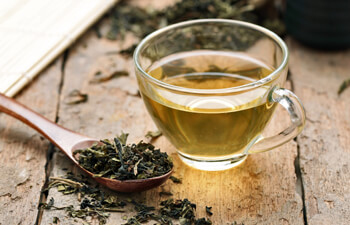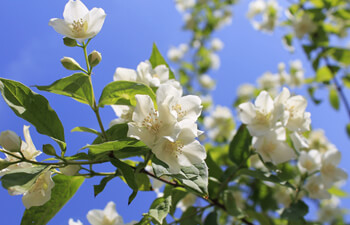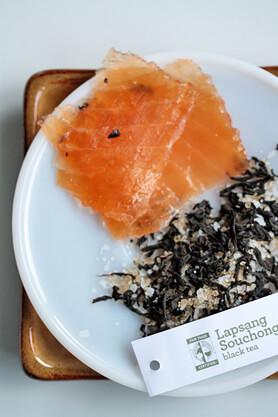Organic Jasmine Pearl Green Tea

The most tender top two organic tea leaves and bud are hand-rolled into small pearls and infused with the essence of jasmine in this classic display tea. Grown and harvested by the Miao farmers of Xinmin Village, this tea is grown at over 5,500 feet above sea level where the days are warm and sunny, and the nights cool and crisp. To create this scented tea, fragrant jasmine blossoms are intermingled with premium, hand rolled green tea pearls according to a traditional tea scenting process that dates back more than nine centuries. The organic green tea absorbs the aroma of the fresh jasmine flowers, making the pearls sweet and fragrant. The blossoms are then removed after the scenting process, leaving only the organic jasmine-infused tea pearls. This process is repeated four to six times for our Organic Jasmine Pearl Green Tea.
This Fair Trade Certified tea is sourced from the southwest region of China’s Guizhou Province (equidistant from the well-known tea regions of Yunnan and Hunan). Interior provinces such as Guizhou have not experienced the same growth in income and alleviation of poverty as the coastal cities and provinces. As a result, tea projects in these more remote regions are a particularly welcome economic development.
The straw-colored infusion of this organic Jasmine Pearl Green Tea yields a much lighter-bodied, and more subtle green tea flavor than our traditional Jasmine Green Tea. However, because the green tea flavor is more subtle, our Jasmine Pearl is perceived as having a stronger jasmine flavor compared to the Jasmine Green Tea.
Ingredients: organic and Fair Trade Certified Chinese green tea
What are Scented Teas?

Scented teas begin with the same top-quality organic tea as our non-scented teas, but are exposed to a particular scent during manufacturing. As a result, the tea absorbs and retains the aroma throughout its lifetime. Some of the most well known scented teas are combined with flowers such as: jasmine, magnolia, and osmanthus. Others are more savory and scented with smoke such as Lapsang Souchong. Scented teas are often confused with flavored teas (which is why we include them in our flavored tea listings), however they are technically unflavored. Sometimes, lesser forms of scented tea are mimicked by using a flavoring.
Steeping Instructions

At Arbor Teas, we believe tea should be brewed to suit your personal taste. We’re happy to make recommendations to get you started, but don’t hesitate to experiment! When brewing your tea, your main considerations are tea quantity, water temperature, and steeping time. We recommend green and white teas to be steeped for 2 to 3 minutes in water heated to not-quite-boiling, just as bubbles begin to form on the bottom of the pan (approximately 170 to 180 degrees F). For the best flavor, use fresh water whenever possible. Try not to steep your tea longer than necessary, as you’ll extract undesirable bitterness from the leaves. If you want a stronger brew, don’t steep longer, just use more tea. And don’t forget to re-steep your tea leaves to get the most out of your leaf!
Looking for more info? Check out our How-To Guides and Eco-Brewing Tips!
Staff Perspectives
 Lea
Lea
"Such a beautiful tea! Take a moment to admire the pearled leaves before infusing them. Then enjoy the deliciously floral and light-bodied liquor they produce."
 Trish
Trish
"I love to make this Jasmine as an iced tea in our Cold Brew Iced Tea Maker. It is so elegant unfurled and the taste of cold jasmine in the summer is a real delight."
 Aubrey
Aubrey
"Infuse this organic tea from China in clear wine glasses to "wow" your dinner guests as they watch it unfurl!"
Health Benefits

Like all true tea, green tea offers many potential health benefits. Research has found that tea (Camellia sinensis) can have many positive effects on human health, including improved cardiovascular function, cancer risk reduction, improved immune function, improved oral health, and help with weight management. Tea is also full of polyphenols, which are a class of antioxidant that help your body maintain homeostasis and balance your stress levels.
Green tea specifically is known for its array of health benefits, which have been supported by a growing number of studies. Green tea research has demonstrated that it may be an effective anticancer agent for breast cancer, lung cancer, kidney cancer and prostate cancer, among others. Studies have shown a link between green tea and weight loss, and the ability to modulate energy metabolism, aid in body fat regulation, and possibly promote preferential loss in abdominal fat. Research has also shown that green tea may increase performance for short term memory tasks, as well as being increasing potency of antibiotics. Other peer-reviewed studies link green tea to healthy skin, help with lowering cholesterol, and regulating diabetes. It’s important to keep in mind that many of these studies monitor subjects who drink several cups of green tea per day.
For more information about the health benefits of green tea, and for direct sources of the above information, check out our Tea Health Benefits page!
Please note: the information above is for educational purposes only and has not been evaluated by the Food and Drug Administration. This information is not intended to diagnose, treat, cure, or prevent any disease.
Jasmine Recipes
Jasmine Scenting and History

Jasmine tea has been a mainstay in Fuzhou, the capital city of Fujian, since the 12th century. It has even outlasted other varieties of scented teas, including rose, orchid, and gardenia teas, which were popular during the Ming Dynasty. Some believe that jasmine tea is the perfect balance of Yin and Yang – the green tea representing the warming Yang and jasmine representing cooling Yin. This perfect balance of Yin and Yang is thought to be harmonious. In fact, in Chinese medicine, jasmine tea is prescribed in the treatment of a variety of conditions – from fevers to inflammation.
In Fujian, when the jasmine blooms, it's time to go to work, harvesting it in large wicker baskets and carrying it to the tea plantations. There, the jasmine is combined with a special selection of green tea that’s held every year in anticipation of jasmine season. The jasmine blooms are layered on top of the green tea, and left overnight, until the scent of jasmine permeates the tea; then, the jasmine is discarded. This process is repeated several times until the tea is perfectly scented. This results in a perfect balance of flavor and aroma - you won't get any of that overwhelming soapy taste that comes with artificially flavored jasmine teas. The tea is then “fired” one more time to prevent spoilage. Then, this intensely floral tea is ready for market.
For even more information about this and other traditions, visit our Tea Traditions Page!











